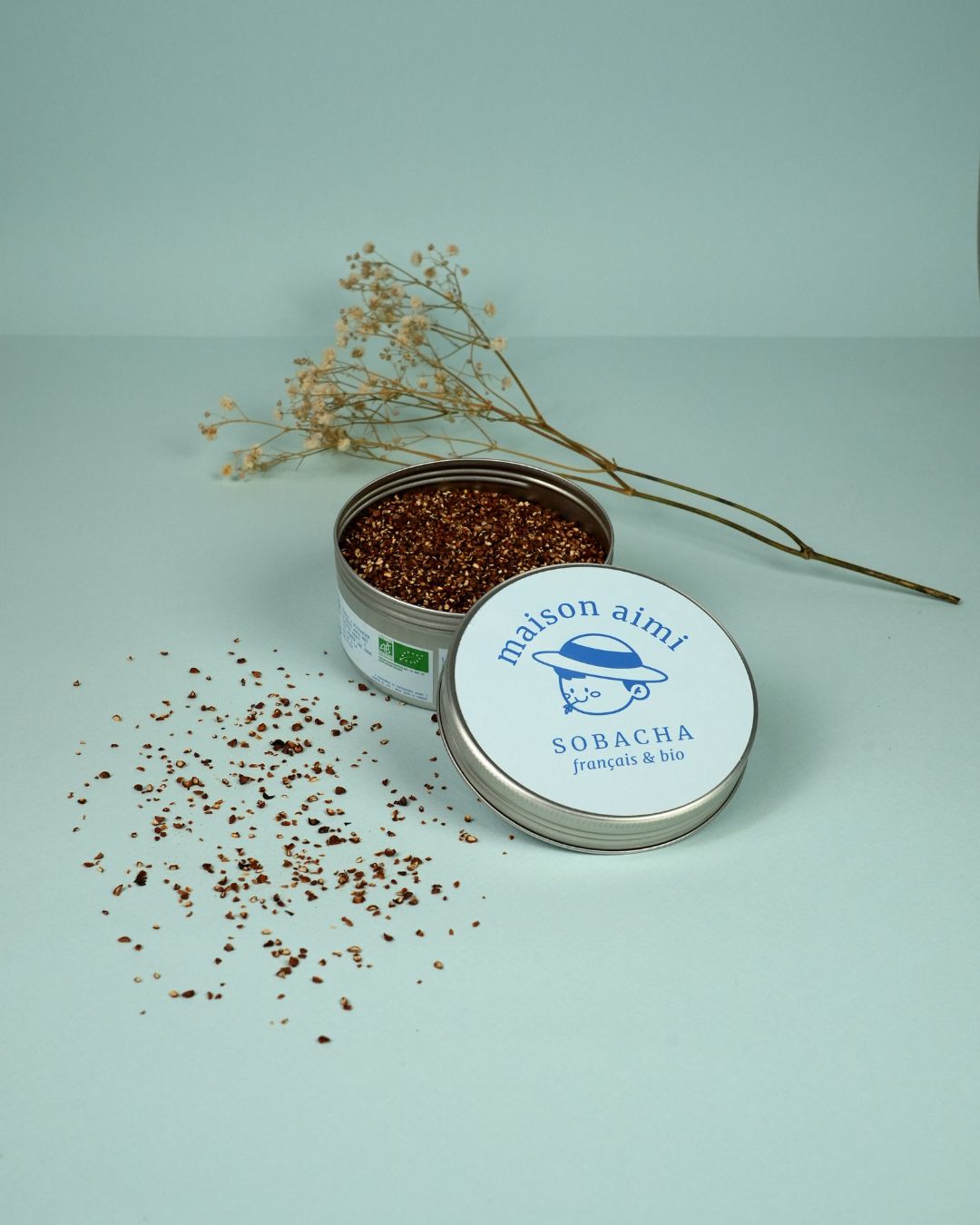Barley, a rustic cereal cultivated throughout the world

Originating from the Middle East and Western Asia , barley and its cultivation have gradually developed to reach the entire world. Particularly known in the brewing world (30 to 40% of the world's barley is intended for the development of malt and beer), barley is used in parallel in different sectors and is of interest for its various benefits. At Maison Aimi, we were particularly interested in this cereal when we discovered mugicha, also called barley tea, in Japan. It became possible to create a 100% French mugicha , a way to enjoy a Japanese drink with local and organic resources! In today's article, let's discover this amazing cereal together!
Summary
Presentation of barley
> Barley in a few words
> His story
> Barley cultivation
> Barley processing
> Barley VS wheat: the differences
Common uses of barley
> Animal feed
> Brewery
Nutritional qualities and benefits of barley cereal
> Nutritional values of barley
> Benefits of barley cereal
Choosing the right barley for you
> How to choose it?
> How to store it?
> How to consume it?
Limits of barley consumption
> Gluten allergy / intolerance
Presentation of barley
Let's start with a little discovery of barley: what is this cereal, how humans began to use it, where it is grown... We'll tell you everything!
Barley in a few words
Common barley , called Hordeum vulgare in Latin, is a cereal. Like wheat (which it closely resembles), oats or millet, it belongs to the family of grasses , plants with tiny flowers grouped in ears and with a hollow stem.
Barley, a herbaceous plant
Barley is a herbaceous plant that is both perennial and annual : it is considered perennial but its short lifespan makes it behave like an annual plant that needs to be replanted every year. Barley measures between 95 and 120 cm high . It is characterized by ears with long pointed extensions , more commonly called awns . Finally, this barley cereal has the characteristic of adapting extremely well to different climates, making it the cereal with the largest cultivation area in the world .
Grain structure
Let's finish this short presentation of barley by focusing on the general structure of the barley grain . It contains three distinct layers : the husk , the almond and the germ .
When the grain retains all its layers, it is called “ whole ” – on the other hand, it will be called “ refined ” if the husk is removed, for example. Whole barley is richer in nutritional value but it can be more difficult to digest than its refined version.
His story
Barley and wheat were the first two cereals to be domesticated by humans and their domestication gave rise to agriculture .
Originating in the Middle East and Western Asia , barley began to be cultivated there in 8000 BC . Its cultivation area expanded as agricultural mastery spread throughout the world. It was then used for food and for the creation of beer: the first traces of beer created from barley date back to 3000-3500 BC.
Barley cultivation
As we mentioned earlier, barley is the cereal that best adapts to the different climates of the world, making it the most widely cultivated cereal in the world. It is thus found in a hundred countries, as well as in Sweden, North Africa, Japan, and France.
With around 148 million tonnes harvested each year worldwide from nearly 50 million hectares, barley is the fourth most cultivated cereal in the world in terms of quantity.
The different varieties
The name “ common barley ”, generally given to barley, comes from the fact that it designates the ancestor of all modern varieties of barley.
Today, there are two varieties of barley cereal:
- Six-row barley : it is recognized by its ear with 6 rows of grains . This variety of barley is characterized by its resistance to cold (down to -15°C) and its high productivity. Barley of this variety is sown in the fall.
- Two-row barley: it is divided into two sub-varieties : winter and spring barley . Two-row winter barley, or escurgeon , is sown around September. This variety of barley is used as feed for livestock , in the brewing industry or for the production of cereals . Two-row spring barley is sown around February-March . More sensitive to frost , it is used in particular for the production of groats and flour .
Barley processing
Barley is found in stores in two forms: hulled barley and pearl barley . These forms differ in appearance but also in nutritional values , and for good reason, these forms designate two different transformations of the grain.
- Barley is called " hulled " ****when only the outer shell has been removed . In this form, the kernel and germ are preserved . The grain retains much of its nutrients .
- Barley is called " pearl " when it undergoes multiple transformations in which it loses its husk, iron and part of the almond. Its nutritional qualities are lower than those of hulled barley but it is quicker to cook and easier to chew.
🌾 By the way: you may have noticed: barley has two genders in the French language. As a cereal , we speak of barley in the feminine , while we must speak of it in the masculine when barley is associated with " mondé " and " perlé ".
Barley VS Wheat: The Differences
Barley is very often confused with its cousin, wheat: these two cereals are however, despite their certain resemblance, very different.
First, in terms of the visual aspect of the plant itself. Barley is a yellow plant and wheat is a pale yellow plant. Furthermore, the barley ear is particularly “hairy” while the wheat ear appears naked.
Then, at the level of the visual aspect of the grain. The barley grain is more rounded and adheres to its envelope, unlike the wheat grain. The wheat grain does not require any real treatment to remove the seed from its envelope while a specific treatment is required to remove the envelope from the barley. While walking along the edge of a meadow, you will have no trouble tasting a grain of wheat.
Finally, the nutritional characteristics of barley and wheat distinguish them. Barley has a much lower protein content and contains less gluten. This may explain why wheat has been preferred over time.
Common uses of barley
Barley is commonly used in three sectors in particular: brewing, animal feed and human food. However, its cultivation area is very wide, so the distribution between these uses depends a lot on the countries where it is grown.
Animal feed
70% of the world's barley production is intended for animal feed, particularly for feeding chickens for the production of eggs and meat (50%).
In France, 1/3 of barley production does not leave the farm where it was grown: it is used directly to feed livestock.
Brewery
In human food, brewing production is the primary use of barley. Many beers are produced by fermenting barley malt, which is produced during the barley malting process (a process that involves germinating the grain so that it produces certain enzymes and sugars).
France is the leading producer of malting barley in the European Union, to which it devotes 36% of its production, and the world's leading exporter of malt. 70% of the beers consumed in France are produced on French territory, while 20% of the beers brewed worldwide are made from French malting barley and malt.
🌾 Did you know? It is estimated that one hectare of barley can produce 35,000 liters of beer .
Human food
In addition to beer, barley, and more precisely, barley malt, is used in the production of whisky. But barley is not only used to produce alcohol. Several products and dishes in the human diet contain barley.
- Barley is increasingly consumed as a side dish like wheat, quinoa or rice grains. It is available in organic stores in bulk or in bags;
- Barley can be ground and eaten as flour, in bread and cakes;
- Barley can be roasted and brewed to be consumed in a drink that is similar to coffee and tea. Barley coffee and barley tea are particularly popular drinks in Italy and Asia. In Japan, barley infusion is called mugicha and it is this that inspired our founder, Charlotte, to create Maison Aimi. Since 2022, we have been offering you 100% French and organic mugicha made from French barley.
Nutritional qualities and benefits of barley cereal
Barley is a cereal with many benefits that it may be interesting to reintegrate into your diet, as part of a healthy and varied diet.
Nutritional values of barley
Hulled barley (cooked, 100g)
In this transformation, only the grain's husk is removed: it retains a large part of its nutrients and, above all, its fibers .
| Calories | 399 kcal |
|---|---|
| Fats (lipids) | 2.3 g |
| Carbohydrates | 56.2 g |
| Fibers | 17.3 g |
| Proteins | 12.5 g |
| Vitamins and minerals | B1 (Thiamine), B2 (Riboflavin), B3 (Niacin), Manganese, Selenium, Magnesium, Iron, Phosphorus, Zinc, Antioxidants |
Pearl barley (cooked, 100 g)
Pearl barley is more refined than hulled barley: its nutritional qualities are lower but it is quicker to cook and easier to chew.
| Calories | 119 kcal |
|---|---|
| Fats (lipids) | 1.16 g |
| Carbohydrates | 68.6 g |
| Fibers | 3.8 g |
| Proteins | 9.91 g |
| Vitamins and minerals | B1 (Thiamine), B2 (Riboflavin), B3 (Niacin), Manganese, Selenium, Magnesium, Iron, Phosphorus, Zinc, Antioxidants |
Benefits of barley cereal
The benefits of barley come largely from its high content of soluble fiber (beta-glucan) and minerals.
Barley, consumed in its whole or refined form:
- slows down digestion (and therefore promotes it)
- accelerates the feeling of satiety
- helps regulate blood sugar levels
- helps trap fats and maintain lower cholesterol levels
- contains antioxidants
- contains phosphorus, magnesium, vitamins E and B, potassium
- contains less gluten than wheat (and can therefore be better tolerated by people with intolerance)
👉 Also read: our article dedicated to the benefits of barley coffee .
Choosing the right barley for you
Want to incorporate barley into your diet? Let’s take a look at how to choose, store, and consume your barley grains.
How to choose it?
Because France is a major producer of barley, we can only recommend that you opt for French barley. As a bonus, choose it organic and in bulk: it will be good for you and for the planet 🌏.
As we mentioned earlier, there is a difference between hulled barley and pearled barley. Our recommendation is to choose hulled barley, which is richer in nutrients and benefits. However, in this form, it requires soaking and requires 60 minutes of cooking–while pearled barley does not need to be soaked. It is up to you to decide whether you prefer to prioritize convenience or nutritional value.
How to store it?
Like all grains, it is important to store your barley grains in an airtight container, cool and away from sunlight. Glass jars with seals are perfect for this purpose.
How to consume it?
You can consume barley:
- in grains, such as wheat or quinoa: in this use, immerse the barley in 4 times its volume of cold salted water. Bring to the boil and simmer over low heat for 1 hour. Hulled barley will need to be soaked for 12 hours while pearl barley will not need it. You can then eat it as a side dish or in a salad;
- into flour to make bread, pies or pancakes;
- in drinks: Maison Aimi specializes in the creation of drinks from Japan and created from French barley. It offers mugicha and mugicha powder to create mugicha lattes and/or to create original pastries.
Limits of barley consumption
Let us conclude this article with two points that we feel are important to share regarding the consumption of barley. What are the limits to its consumption?
Gluten allergy/intolerance
Although it contains less gluten than its cousin wheat, barley does contain gluten. This makes its consumption by people with celiac disease (allergy to gluten) completely impossible. For people with gluten intolerance, seeking to limit it, particularly as part of an anti-inflammatory diet, eating it may be interesting.
🌾 Barley infusion does not contain gluten and may be interesting if you want to enjoy the benefits of barley without the gluten.
The first cultivated cereal in history with wheat, the use of barley has gradually shifted from human food to animal feed and brewing, making it a less noble cereal than wheat. However, it has many nutritional virtues and interesting benefits and deserves to find a place on our table. This is all the more so because it is widely cultivated in France.


